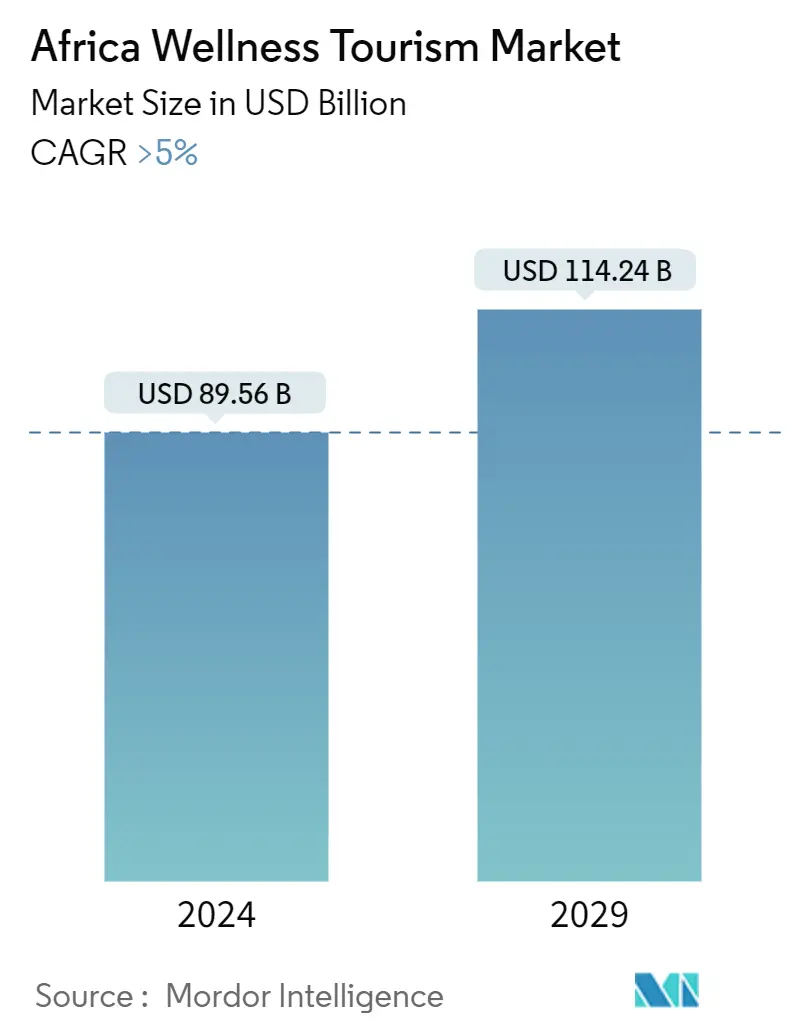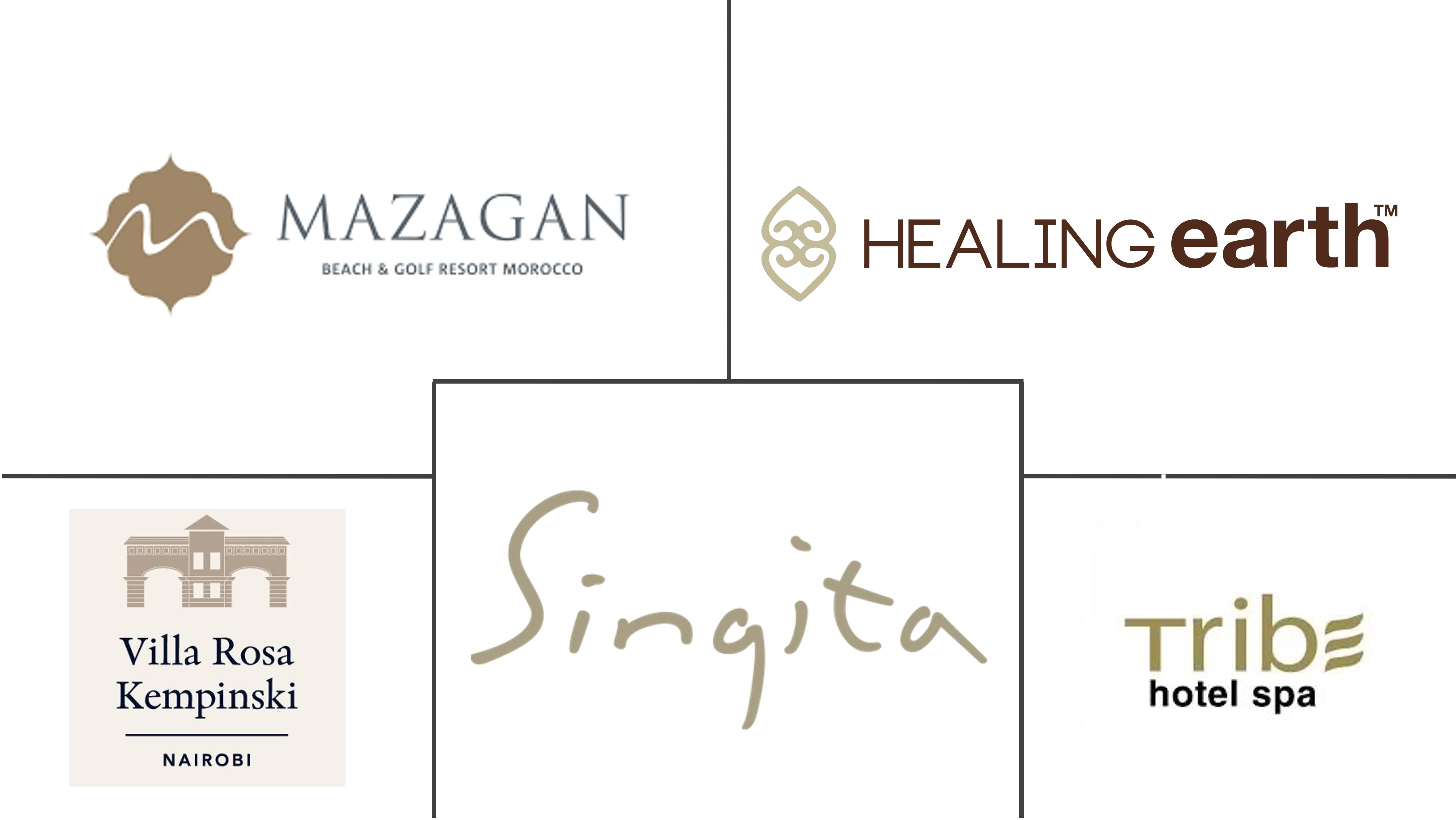Market Size of Africa Wellness Tourism Industry

| Study Period | 2020-2029 |
| Base Year For Estimation | 2023 |
| Market Size (2024) | USD 89.56 Billion |
| Market Size (2029) | USD 114.24 Billion |
| CAGR (2024 - 2029) | 5.00 % |
| Market Concentration | Low |
Major Players
*Disclaimer: Major Players sorted in no particular order |
Africa Wellness Tourism Market Analysis
The Africa Wellness Tourism Market size is estimated at USD 89.56 billion in 2024, and is expected to reach USD 114.24 billion by 2029, growing at a CAGR of greater than 5% during the forecast period (2024-2029).
Wellness tourism is becoming a popular tourism sector as more spas open across East Africa. It is, therefore, increasingly important to have some quality control and certification process in place to ensure that domestic and international guests with high expectations are getting value for money. For example, Uzuri Spa (Leopard Beach Resort & Spa) in Kenya is very sophisticated and is sure to attract an elite market. The hotel has its own branded spa and salon. African safari tourists can pamper themselves and relax in Holmen. In particular, newly opened hotels and lodges have world-class spas, which help them successfully compete in the hotel tourism market.
The rising interest of tourists in sectors such as health, travel, and food are the factors driving the market growth during the forecast period. Factors such as increasing disposable income are increasing customer spending on various social and health wellness services, thereby expected to grow the market. The wellness tourism market is driven by increasingly hectic lifestyles characterized by work-related stress, resulting in a preference for services such as spas, yoga programs, accommodation, and meals, among others.
Vendors in the market are focused on providing quality services to gain competitive advantage. An increasing number of market participants focus on offering advantageous and customized service packages targeted at different consumer groups, increasing competition in the market and increasing the number of consumers opting for experiential travel.
Africa Wellness Tourism Industry Segmentation
Africa's wellness tourism market is segmented by travel type (domestic and international), activity (in-country transport, lodging, food and beverage, shopping, activities and excursions, and other services), purpose (primary and secondary), and geography (Tunisia, Morocco, Kenya, Egypt, Tanzania, Mauritius, Ethiopia, South Africa, and other countries).
The report offers market size and forecasts for all the above segments in terms of value (USD) and volume (Ton).
| By Travel Type | |||||||||||
| Domestic | |||||||||||
| International | |||||||||||
| |||||||||||
| |||||||||||
|
Africa Wellness Tourism Market Size Summary
The Africa Wellness Tourism Market is experiencing significant growth, driven by an increasing interest in health, travel, and food among tourists. This sector is gaining popularity as more spas and wellness facilities open across East Africa, catering to both domestic and international visitors seeking high-quality experiences. The market is characterized by a rise in disposable income, which is boosting consumer spending on wellness services such as spas, yoga programs, and health-focused accommodations. Vendors are focusing on providing quality and customized service packages to gain a competitive edge, leading to increased competition and a growing number of consumers opting for experiential travel. South Africa, with its rich cultural and natural resources, is a key player in this market, attracting international tourists with its wellness offerings.
Luxury travel in Africa is evolving, with more travelers seeking wellness and holistic experiences even in remote destinations. This shift is prompting luxury hospitality businesses to enhance their wellness offerings, focusing on thoughtful guest experiences that cater to individual needs. Major players in the market, such as Villa Rosa Kempinski, Singita, Healing Earth, Tribe Hotel, and Mazagan Beach and Golf Resort, are dominating the sector, but mid-size and smaller companies are also expanding their presence through technological advancements and product innovations. Partnerships and training programs, like those initiated by Singita and Healing Earth, are further strengthening the market's growth and international recognition.
Africa Wellness Tourism Market Size - Table of Contents
-
1. MARKET DYNAMICS
-
1.1 Market Overview
-
1.2 Market Drivers
-
1.2.1 Increasing demand for healthy living, stress reduction, meditation and other activities
-
-
1.3 Market Restraints
-
1.3.1 Government travel and tourism policies and regulations
-
-
1.4 Market Opportunities
-
1.4.1 Increasing awareness of a healthy lifestyle
-
-
1.5 Porter's Five Forces Analysis
-
1.5.1 Bargaining Power of Suppliers
-
1.5.2 Bargaining Power of Buyers/Consumers
-
1.5.3 Threat of New Entrants
-
1.5.4 Threat of Substitute Products
-
1.5.5 Intensity of Competitive Rivalry
-
-
1.6 Impact of COVID-19 on the market
-
1.7 Insights into technological advancements in the furniture industry
-
-
2. MARKET SEGMENTATION
-
2.1 By Travel Type
-
2.1.1 Domestic
-
2.1.2 International
-
2.1.3 By Activity
-
2.1.3.1 In-Country Transport
-
2.1.3.2 Lodging
-
2.1.3.3 Food and Beverage
-
2.1.3.4 Shopping
-
2.1.3.5 Activities and Excursions
-
2.1.3.6 Other Services
-
-
2.1.4 By Purpose
-
2.1.4.1 Primary
-
2.1.4.2 Secondary
-
-
2.1.5 By Geography
-
2.1.5.1 Tunisia
-
2.1.5.2 Morocco
-
2.1.5.3 Kenya
-
2.1.5.4 Egypt
-
2.1.5.5 Tanzania
-
2.1.5.6 Mauritius
-
2.1.5.7 Ethiopia
-
2.1.5.8 South Africa
-
2.1.5.9 Other Countries
-
-
-
Africa Wellness Tourism Market Size FAQs
How big is the Africa Wellness Tourism Market?
The Africa Wellness Tourism Market size is expected to reach USD 89.56 billion in 2024 and grow at a CAGR of greater than 5% to reach USD 114.24 billion by 2029.
What is the current Africa Wellness Tourism Market size?
In 2024, the Africa Wellness Tourism Market size is expected to reach USD 89.56 billion.

